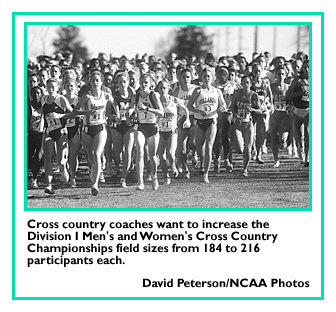The NCAA News - News & FeaturesOctober 28, 1996
Numbers Game
Concerned that participation
at national championships isn't
proportionate to sponsorship,
cross country coaches are lobbying
for increased representation
BY STEPHEN R. HAGWELL
STAFF WRITER
In terms of sponsorship, cross country is among the most popular NCAA sports, ranking near the top in Division I.

In a sport-by-sport comparison of championships participation numbers, however, cross country ranks among the lowest of all Division I sports.
Cross country coaches want that to change.
Frustrated by what they see as underrepresenation for their sport at national championships, Division I coaches are advocating an increase in field sizes at the NCAA Division I Men's and Women's Cross Country Championships.
"Our numbers in terms of participation at the national championships have never been proportionate with our (sponsorship) numbers," said Vin Lananna, men's cross country coach at Stanford University and president of the United States Cross Country Coaches Association. "Our numbers have always been smaller than what they're supposed to be, given the number of schools that actually sponsor cross country.
"We feel it's time that our numbers were increased to more accurately reflect our participation and sponsorship."
In an attempt to remedy the disparity, the NCAA Men's and Women's Track and Field Committee has asked the NCAA Executive Committee to increase the Division I men's and women's championships field sizes from 184 to 216 participants each, effective with the 1997 championships.
The proposal, resulting from the combined efforts of the men's and women's coaches associations, provides for an increase of five seven-person teams at both the men's and women's championships. The additional five teams would be selected at large.
Individually, the proposal recommends that the number of participants be decreased by three. Currently, the championships comprise 22 teams and 30 individual competitors.
'It's time'
"We believe it's time that our numbers were brought up to the level of other sports," said Teri Jordan, women's cross country coach at Pennsylvania State University and president of the Women's Intercollegiate Cross Country Coaches Association. "Our representation is grossly out of proportion. When we look at sponsoring teams, cross country has one of the highest proportions among NCAA sports. But yet, when you look at the number of people that are represented (at the championships), the numbers are very far off."
Based on 1995-96 sponsorship data, cross country ranks second behind basketball in Division I sponsorship numbers with 292 men's and 299 women's programs. However, at national championships, cross country advances on average one team for every 13 institutions that sponsor the sport. By comparison, numerous sports with lower sponsorship numbers advance a ratio of approximately 1 to 5 or 1 to 6.
"It's really a numbers game," Lananna said. "There are nearly 300 schools that sponsor cross country and yet, we get only 22 teams. I don't think there are any sports that are as underrepresented when you look at the number of potential teams that can qualify for the NCAA championships."
Coaches' concern about a lack of championships numbers is not new. For years, coaches have seen other sports gain increased championships field sizes as sponsorship numbers grow.
They believe cross country has been the exception.
Men's and women's cross country has experienced a 13 percent growth in sponsorship since the mid-1980s; however, the championships field size has remained constant. The men's championships have been allotted 184 participants since 1981; the women's championships were increased from 136 to 184 participants in 1989.
"We feel this is a perfect time to take care of something that's been in error for some time," Jordan said. "Even though adding five teams wouldn't be totally representative of our numbers, it gets us closer."
Districts realigned
The proposal to increase championships field sizes comes less than three months after the Executive Committee approved a Division I redistricting plan proposed by the Track and Field Committee that alters the current district alignment and the formula for men's and women's championships selection, effective with the 1997 championships.
Under that plan, schools will be realigned from the current eight districts to nine districts. Each district will be allotted two automatic team berths and three automatic individual berths. Any remaining teams will be selected at large.
As a result of approval of the redistricting plan, Jordan believes an increase in championships participation is necessary to ensure that the nation's top teams advance to the championships. She contends that the current allotment of four at-large selections is not sufficient to guarantee the advancement of the nation's best teams.
Further, she says, if championships field sizes are not increased, the gains realized with the redistricting plan will be lost.
"Right now, we're not guaranteed of getting the top 10 teams because each district gets two automatic bids," Jordan said. "By increasing numbers, we can be assured that the top 10 teams will be at nationals."
Lananna agrees. He said the redistricting plan and the proposal to increase numbers -- although proposed separately -- are intertwined.
"The difficulty with redistricting, in my opinion, is that I don't think it addresses necessarily getting the best teams to the NCAAs," Lananna said. "It does solve the numbers problem, but it doesn't necessarily mean that we're getting the best teams at the nationals.
"That's why this proposal is so very, very important. If we can increase our numbers, we can create a more equitable and fair process."
Fairness, according to Jordan, is the basis for the proposal.
"This is the most fair thing for our sport," she said. "By realigning the districts, we've made it fair for all regions.
"We did what's best for our sport by adding another region. Now, we're asking the NCAA to make it fair for our representation."
|